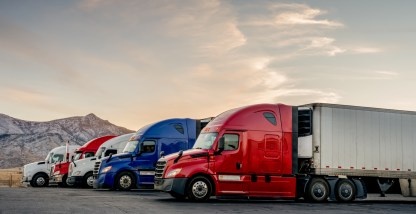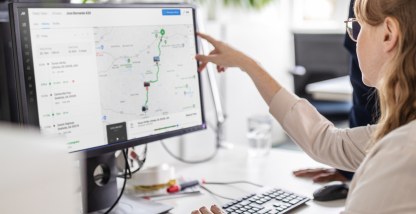Big business can be a complicated business. For enterprise fleets, the last few years have served as a potent reminder of that. Increased demand created a backlog of goods at the largest U.S. ports. And a lack of personnel to move freight further complicated matters. Especially a shortage of truck drivers that stands at 78,000, according to the American Trucking Associations (ATA).
The larger your business becomes, the easier it is to lose sight of the small-business mindset that brought your first taste of success. And yet the steps you took in your company’s earliest days can still work.
Enterprise fleets like PS Logistics are rediscovering the wisdom of “thinking small to go big.” Along the way, they’re becoming more strategic, emphasizing the personal, and tightening their focus. By following the tips below, you can too.
1. Establish a “small village” culture
With 3,700 employees across 13 companies, PS Logistics has been described as “a bustling city” with organized neighborhoods that allow for personalization at scale. As big as PS Logistics has become, the company has maintained its neighborhood feel. It’s a quality that has strengthened work relationships and enhanced driver satisfaction.
“Maintaining a small village culture has been a major focus at PS Logistics as we have grown and tried to maintain a sense of what made us attractive when we were smaller,” says Kim Daigle, VP of Human Resources at PS Logistics, based in Ensley, Alabama.
“Starting out, driver managers could talk to the president of the company and see if we could improve the situation for a specific driver,” Daigle says. “As we grew, we couldn’t have everyone walking into the president’s office anymore, so we empowered driver managers to make decisions.”
The move allowed mid-level managers to address drivers’ concerns as they arose instead of allowing problems to fester. “Timely communication helped to resolve issues quickly and establish trust,” Daigle says.
Simulating the feel of a small village isn’t easy for large fleets. Managers can make the mistake of thinking more about the vehicle than driver well-being.
“They almost make the person into a piece of equipment,” Daigle says. “It happens when large companies try to allocate more drivers to fewer managers. You can solve that problem by keeping the driver-to-manager ratio low. By keeping that ratio low, each manager is able to think of the individuals that he or she is managing instead of vehicle numbers.”
2. Focus on people, not problems
People management is one of the most important fleet manager responsibilities.
Small fleets tend to have a family atmosphere where coworkers know each other well. But a close-knit vibe doesn’t have to be exclusive to small fleets. By maintaining or reproducing that supportive, cohesive vibe, large fleets can maintain the personal touch that first made them special.
The key, says Allison Wiers, leader of marketing and retention at Dutch Maid Logistics, is access. With about 240 employees at the mid-sized fleet, Dutch Maid workers have frequent access to one another. The result is an invested workforce.
“Here at Dutch Maid, we were able to see each other face-to-face during the pandemic,” Wiers says. “Managers and drivers were able to have in-person conversations in the yard. At our size, our company president is able to call everyone who works here on their birthday. So I think access is a big factor in keeping it personal and allowing for one-on-one communication.”
3. Communicate frequently and positively
Breakdowns in communication can break relationships, putting workers at risk of leaving. Keeping the lines of communication open is pivotal to retention.
WorkHound, a feedback platform for the frontline workforce, recently released a report on How to Disrupt Turnover. The report found that disengaged workers made 178% more comments about communication than their satisfied peers did.
“We know that poor communication can quickly lead to at-risk workers, and that at-risk workers regularly voice their concerns about ineffective or incomplete communication,” says WorkHound Co-founder and CEO Max Farrell. “That’s why making multiple touchpoints with your team each week is a valuable retention tactic.”
While disengaged drivers say a lack of communication makes them feel unappreciated, the most invested drivers say they feel informed and connected. The WorkHound report showed that drivers at small and medium-sized fleets made 50% more praise comments than those at large fleets did, and that 30% of all praise was about people.
“The substantial lack of praise at large companies is probably a symptom of poor communication,” Farrell observes. “At small fleets, drivers are accustomed to more frequent communication. Drivers at companies of all sizes may benefit from being contacted more often, not only when something goes wrong.”
4. Make sure drivers understand how and when they’ll be paid
Establishing clarity about driver pay from the start sends a strong signal that your company is transparent and values driver satisfaction. About 40% of all WorkHound pay data shows that drivers don’t understand their pay or are paid incorrectly.
“Reviewing pay and pay frequency early in onboarding is a sign of trust-building,” Farrell explains. “It shows that the company is trying to get an employee’s pay correct from the very beginning.”
Managers at PS Logistics address pay during a driver’s first week. “It may be as simple as ‘Let’s go over your settlement and make sure you understand what you’re being paid for and how you’re being paid,’” Daigle says. “After a few weeks, managers and drivers review the pay process again, because not everything is going to sink in after the first week.”
According to a report by the popular HR company Workday, disengaged employees start showing declining engagement and loyalty nine months before they leave a company. A lack of communication about pay can inspire employees to leave.
“Even when employees feel they’re appropriately rewarded, the inability to talk openly about pay with their managers can cause employees to disengage and become more likely to quit,” the report states. “This suggests that the ability to have discussions with a manager about rewards ties into an employee’s sense of self-worth. It supports their sense that the company respects them.”
5. Treat drivers like customers
Too often, businesses focus on customer satisfaction at the expense of employee satisfaction. Treating drivers like customers is an effective business strategy. One that can strengthen driver retention and company loyalty.
In the Forbes article “Treating Employees Like Customers: Why It’s Your Best Performance Strategy,” writer Heather V. MacArthur recommends training managers to provide great employee service just as they learn to provide great customer service. Holding managers accountable for how they lead, and making sure they’re comfortable receiving feedback, “sends a strong message that all employees matter,” MacArthur writes.
For more great tips on getting the most from your team, check out 10 top takeaways from the best fleets.










